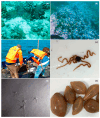Typical Marine Ecological Disasters in China Attributed to Marine Organisms and Their Significant Insights
- PMID: 39336105
- PMCID: PMC11429238
- DOI: 10.3390/biology13090678
Typical Marine Ecological Disasters in China Attributed to Marine Organisms and Their Significant Insights
Abstract
Owing to global climate change or the ever-more frequent human activities in the offshore areas, it is highly probable that an imbalance in the offshore ecosystem has been induced. However, the importance of maintaining and protecting marine ecosystems' balance cannot be overstated. In recent years, various marine disasters have occurred frequently, such as harmful algal blooms (green tides and red tides), storm surge disasters, wave disasters, sea ice disasters, and tsunami disasters. Additionally, overpopulation of certain marine organisms (particularly marine faunas) has led to marine disasters, threatening both marine ecosystems and human safety. The marine ecological disaster monitoring system in China primarily focuses on monitoring and controlling the outbreak of green tides (mainly caused by outbreaks of some Ulva species) and red tides (mainly caused by outbreaks of some diatom and dinoflagellate species). Currently, there are outbreaks of Cnidaria (Hydrozoa and Scyphozoa organisms; outbreak species are frequently referred to as jellyfish), Annelida (Urechis unicinctus Drasche, 1880), Mollusca (Philine kinglipini S. Tchang, 1934), Arthropoda (Acetes chinensis Hansen, 1919), and Echinodermata (Asteroidea organisms, Ophiuroidea organisms, and Acaudina molpadioides Semper, 1867) in China. They not only cause significant damage to marine fisheries, tourism, coastal industries, and ship navigation but also have profound impacts on marine ecosystems, especially near nuclear power plants, sea bathing beaches, and infrastructures, posing threats to human lives. Therefore, this review provides a detailed introduction to the marine organisms (especially marine fauna species) causing marine biological disasters in China, the current outbreak situations, and the biological backgrounds of these outbreaks. This review also provides an analysis of the causes of these outbreaks. Furthermore, it presents future prospects for marine biological disasters, proposing corresponding measures and advocating for enhanced resource utilization and fundamental research. It is recommended that future efforts focus on improving the monitoring of marine biological disasters and integrating them into the marine ecological disaster monitoring system. The aim of this review is to offer reference information and constructive suggestions for enhancing future monitoring, early warning systems, and prevention efforts related to marine ecological disasters in support of the healthy development and stable operation of marine ecosystems.
Keywords: Annelida; Arthropoda; Cnidaria; Echinodermata; Mollusca; harmful algal blooms; marine ecological disasters; marine management.
Conflict of interest statement
The authors declare no conflicts of interest.
Figures





Similar articles
-
Evolutionary trends and analysis of the driving factors of Ulva prolifera green tides: A study based on the random forest algorithm and multisource remote sensing images.Mar Environ Res. 2024 Jun;198:106495. doi: 10.1016/j.marenvres.2024.106495. Epub 2024 Apr 15. Mar Environ Res. 2024. PMID: 38688108
-
Biogenic element driving mechanism in the occurrence of Chinese coastal eco-environmental disasters and regulation for ecological environment health.Ying Yong Sheng Tai Xue Bao. 2024 Feb;35(2):564-576. doi: 10.13287/j.1001-9332.202402.018. Ying Yong Sheng Tai Xue Bao. 2024. PMID: 38523115 English.
-
Hydroids (Cnidaria, Hydrozoa) from Mauritanian Coral Mounds.Zootaxa. 2020 Nov 16;4878(3):zootaxa.4878.3.2. doi: 10.11646/zootaxa.4878.3.2. Zootaxa. 2020. PMID: 33311142
-
The Minderoo-Monaco Commission on Plastics and Human Health.Ann Glob Health. 2023 Mar 21;89(1):23. doi: 10.5334/aogh.4056. eCollection 2023. Ann Glob Health. 2023. PMID: 36969097 Free PMC article. Review.
-
Marine harmful algal blooms (HABs) in the United States: History, current status and future trends.Harmful Algae. 2021 Feb;102:101975. doi: 10.1016/j.hal.2021.101975. Epub 2021 Mar 3. Harmful Algae. 2021. PMID: 33875183 Free PMC article. Review.
Cited by
-
Biology, Ecology and Management of Aquatic Macrophytes and Algae (Volume I).Biology (Basel). 2025 Feb 28;14(3):246. doi: 10.3390/biology14030246. Biology (Basel). 2025. PMID: 40136503 Free PMC article.
References
-
- Xu C., Yang Y., Zhang F., Li R., Li Z., Wang Y.P., Jia J. Spatial-temporal distribution of tropical cyclone activity on the eastern sea area of China since the late 1940s. Estuar. Coast. Shelf Sci. 2022;277:108067. doi: 10.1016/j.ecss.2022.108067. - DOI
-
- Rabinovich A.B., Titov V.V., Moore C.W., Eblé M.C. The 2004 Sumatra tsunami in the Southeastern Pacific Ocean: New Global Insight from Observations and Modeling. J. Geophys. Res. Ocean. 2017;122:7992–8019. doi: 10.1002/2017JC013078. - DOI
-
- Lahcene E., Ioannou I., Suppasri A., Pakoksung K., Paulik R., Syamsidik S., Bouchette F., Imamura F. Characteristics of building fragility curves for seismic and non-seismic tsunamis: Case studies of the 2018 Sunda Strait, 2018 Sulawesi-Palu, and 2004 Indian Ocean tsunamis. Nat. Hazards Earth Syst. Sci. 2021;21:2313–2344. doi: 10.5194/nhess-21-2313-2021. - DOI
-
- Blunden J. State of the climate in 2021. Bull. Am. Meteorol. Soc. 2022;103:S1–S465. doi: 10.1175/2022BAMSStateoftheClimate.1. - DOI
Publication types
Grants and funding
LinkOut - more resources
Full Text Sources

